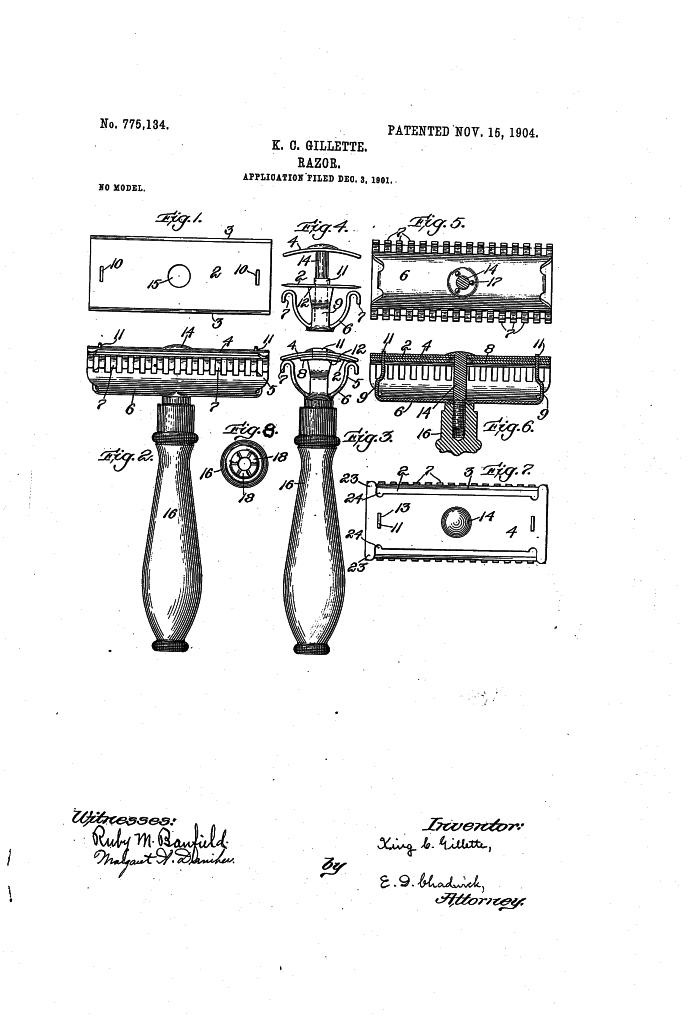Despite the transient nature of the definition of "design", an important role of the designer is unquestionably solving problems. And an important role of the industrial designer is solving problems in context of industrial production.
One of the earliest, and most elegant, examples of this dates back to the very beginnings of industrial production: the disposable safety razor blade. The patent for which was granted to King Camp Gillette on November 15th 1904.
According to popular legend the enterprise began in 1895 when King C Gillette was working as a travelling salesman for the Crown Cork & Seal company. William Painter, head of the company and inventor of both the crown cap and, somewhat brilliantly, the bottle opener, gave the ambitious Gillette the advice that if he wanted to get rich he should, "invent something people use and throw away"; which of course is the capitalist's contorted version of "Give a man a fish and you feed for a day, teach a man to fish and you feed him for a lifetime" - "Sell a man a fish and you feed him for a day, teach a man to fish and you destroy your business model"
Shortly after receiving these words of wisdom King C Gillette had his eureka moment while shaving, or at least attempting to shave; his efforts being hampered by the ubiquitous shaver's problem of the day, a blunt blade.
Or as Gillette phrased it in his patent application from December 3rd 1901, the problem with the contemporary safety razor was the "considerable amount of trouble, time, and expense on the part of the user in keeping the blades sharp, not only for the reason that the blades used in razors of this type require to be stropped and honed frequently, which cannot be done satisfactorily by the average individual user himself, but also for the reason that the blades are worn out by honing and have to be replaced at considerable expense."
For Gillette the solution to freeing man from this time, trouble and expense was a thin, sharp disposable blade. A blade which was sharp when bought and which when blunt could be simply disposed of and replaced with a new, sharp, blade. The secret of such, deduced Gillette, was creating a steel blade with as thin an edge as possible.
Lacking the technical skills to realise his project by himself, Gillette approached the Massachusetts Institute of Technology, MIT with the aim of winning them as a cooperation partner. The MIT, considering Gillette's idea unworkable, declined; however, during the negotiations King C Gillette was introduced to the engineer, MIT graduate and amateur inventor, William Nickerson, a man who possessed not only the necessary technical skills but also the vision lacked by his alma mater.
Over the following six years Gillette and Nickerson worked tirelessly on their plan until in 1901 they had not only a machine capable of producing blades of the required quality, but a patent application for the invention.
Granted to King C Gillette on November 15th 1904 US Patent 775134 describes a safety razor in which a very thin steel blade is contained in a holder "so constructed as to provide a rigid backing and support for the blade, as well as a handle therefore so that although my blade itself is readily flexible by reason of its thinness and lacks the rigidity of the ordinary razor-blade yet when it is combined with its holder it receives a degree of rigidity sufficient to make it practically operative", and in addition "which enables me to utilize the flexibility and elasticity of my blades in a very advantageous manner, my holder being also simple in construction and easily cleaned and having other advantages which will hereinafter appear."
Such as creating a ready, insatiable, global market for new blades.
And while Gillette may no longer have the monopoly Patent No 775134 once offered them, Gillette and Nickerson's disposable blade remains a highly profitable system and a powerful example of the benefits targeted design thinking can bring to both industry and society.
And a powerful example of the global truth that not only does nothing sell like that which one has to throw away, but nothing continues selling like that which locks the user into dependency.
Then it was razor blades. Today it's smartphones. And razor blades.
